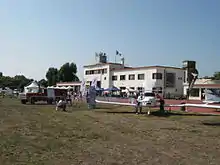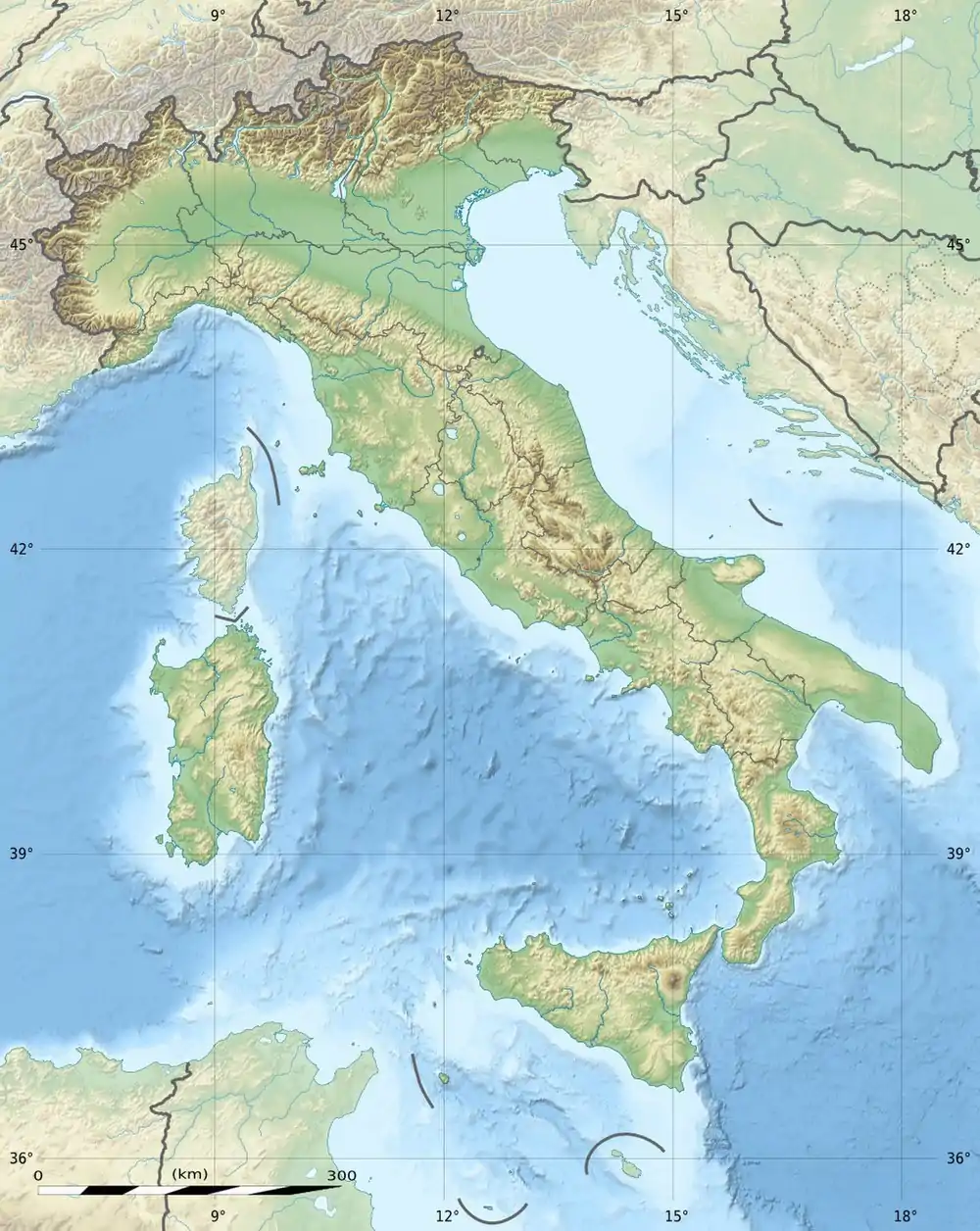Venice-Lido Airport
Venice-Lido Airport (Italian: Aeroporto di Venezia-Lido, ICAO: LIPV) is an aerodrome located 1.9 nautical miles (3.5 km; 2.2 mi) east of Venice (Venezia),[1] a city in the Veneto region in Italy.[2] It is situated on the north end of the island of Lido di Venezia. It is also known as Giovanni Nicelli Airport[3] and was formerly known as Venice-San Nicolò Airport
Venice-Lido Airport Aeroporto di Venezia-Lido | |||||||||||
|---|---|---|---|---|---|---|---|---|---|---|---|
 | |||||||||||
| Summary | |||||||||||
| Airport type | Public | ||||||||||
| Operator | Nicelli S.p.A. | ||||||||||
| Serves | Venice (Venezia), Italy | ||||||||||
| Location | Lido di Venezia | ||||||||||
| Elevation AMSL | 13 ft / 4 m | ||||||||||
| Coordinates | 45°25′44″N 12°23′16″E | ||||||||||
| Map | |||||||||||
 LIPV Location of airport in Italy | |||||||||||
| Runways | |||||||||||
| |||||||||||
Nicelli is a general aviation airport, and since March 2019, thanks to a new administration, it has come back to life with a fresh reorganization and restructuring. Located in the prestigious setting of Lido of Venice in the norther part of the island, the airport is only ten minutes by boat from the city center. The gras runway is 994x45 m (3264x148 ft), with orientation 05/23. The airport is also equipped with a helipad, with a 25x35 m (82x114 ft) grass landing area. Equipped with elegant indoor spaces and large gardens and outdoor terraces, it is the ideal location for meetings and conferences, dinners and private event, exclusive parties, art exhibitions and film shoots.
History
The long and fascinating history of the Giovanni Nicelli Airport begins around the 1920s when the Lido of Venice became a cultured destination, located between the sea and the lagoon. It is precisely in that stimulating environment that a young entrepreneur from Ancona, the 24-years-old engineer Renato Morandi, conceives the first Italian civil airport, when not even major cities like Rome and Milan didn’t yet dedicated a commercial traffic hub. The passenger station of the airport was solemnly inaugurated by the Duke of Genova on February 4th, 1935. The airport was in fact defined as the best one in Italy, the most modern, innovative and equipped with various services. The entire operation was managed by the Province of Venice which, thanks to an agreement with the administration of the Aeronautics, acted as “commissioned body”. The architect of the structure was Mario Emmer while the decorations and interiors of the structure were entrusted to Giovanni Nei Pasinetti.
The first flight of an airplane over Venice, a French Farman II, piloted by the car champion Alessandro Umberto Cagno, dates back to 1911 and was the result of an advertising initiative by the Compagnia Italiana Grandi Alberghi to attract and entertain the rich clientele.
After that first experience, the aeronautical exhibitions continued and, in the spring of 1914, an advertisement from the Hôtel Excelsior warned future customers that two seaplanes would be available for their enjoyment. The outbreak of the First World War canceled the initiative.
The importance of the lagoon city as a base for military seaplanes was soon understood by the Regia Marina, which on 25 April 1913, the feast of San Marco, baptized the birth of the first seaplane squadron in the world, with the name of San Marco and based at the Arsenale. The piloting school was annexed to the squadron, thus realizing a project proposed since 30 October 1912 by the frigate captain Ludovico de Filippi, patented in Centocelle in 1910 and deputy inspector of the Aeronautical Services of the Ministry of War since 6 April 1911 At first, the school's activity took place in the Vergini canal, near the Arsenale, but shortly afterwards it was transferred to the new seaplane base, built in the canal of the fort of S. Andrea, on the Vignole island, not far away. from the Lido inlet. The school's staff consisted of the S. Marco Squadron, which initially used 8 heterogeneous seaplanes (one Knee hydro, three Borel 100 Hp, one Borel 80 Hp, two Curtiss Paulham 1912 and one Bréguet). On 26 April 1912 the Caproni aviation school, using a Ca.12, also carried out the first transport of a paying passenger in Italy. At the outbreak of the First World War, Venice was easily exposed to attacks by Austrian bombers, which hit the city from the first day.
The Italian and French aviation departments worked effectively in numerous reconnaissance missions, bombing of enemy bases and defense of the city. From 11 March 1918, the Lido also saw the birth of the 1st naval squadron S.A. (or First Air Torpedo Naval Squadron), under the command of the writer and Major Gabriele d'Annunzio, who remained there until autumn 1919. In late spring 1918 the 241st Squadron was also born there. The Regia Marina, in 1918, created the 241st Squadron here, commanded by Lieutenant Luigi Bologna and to which the Lieutenants Giorgio Parodi and Giovanni Ravelli belonged, equipped with at least 9 Hanriot HD.1 and 3 Nieuport 10 and Nieuport 17 for training .
After the war, on August 18, 1926, the first Italian scheduled flight took off from the runway of San Nicolò al Lido airport, operated by the Società Anonima Transadriatica company managed by the engineer Renato Morandi; it was directed to Vienna via Klagenfurt and it was operated with three-engine Junkers G 24. The Lido airport, baptized “Giovanni Nicelli”, thus became the first airport in Italy. The line was extended the following year to Rome-Foligno-Venice-Vienna, again by the Transadriatica Anonymous Society. In 1927 and 1928, the famous aviator Mario de Bernardi achieved the world records in flight speed here, aboard a Macchi M.52 and a Macchi M.52bis. In the 1950s, the airport began its decline; all the companies that operated there moved, first to Treviso (1953), then to the new Tessera airport (1960). In 1974 the Aeronavali Workshops were also moved to Tessera. The airport, for years, remained active only thanks to the local Aeroclub.
Its airport is the only one in Italy to have remained unscathed from the bombings of the Second World War and today testifies to the typical architectural style of the 1930s terminals; in it, there is a fresco depicting a map of the overhead lines of the period.
Acknowledgments & Appearances
In 2014 the airport was included in the list of the ten most beautiful in the world drawn up by the BBC by Jonathan Glancey.
“Set on the Venice Lido, a few minutes by water taxi from St Mark’s Square, Nicelli Airport is one of Europe’s most delightful city airports. It serves second fiddle to the international airport – Marco Polo – on the other side of the lagoon, yet it is beautifully located and its terminal building is a strikingly handsome design from 1935. Here, the bright arrivals and departure lounge is happily dominated by a grand piano and surrounded by stirring murals of 1930s aircraft by the Futurist artist Tato (Guglielmo Sansoni). Set between the lagoon, a medieval church and other historic buildings, the airport can be reached on foot, bike or boat.” – (Glancey)[4]
The airport, an example of perfectly preserved 1930s architecture, begun in 1926 and solemnly inaugurated on February 4, 1935, is the oldest commercial port in Italy. It is also artistic heritage of the Italian Republic.
Given the great location, it was also the set of various memorable scenes of the historic tv series “Winds of War”, 1983.
Facilities
The airport resides at an elevation of 13 feet (4 m) above mean sea level. It has one runway designated 05/23 with a grass surface measuring 994 by 45 metres (3,261 ft × 148 ft).[1]
What the airport offers
- Organization of events
- Restaurant
- Airport operations assistance
- Water-taxi service
- Glass factory visit service
- Car-taxi service
- Storage & offices renting
- Bike & electric scooter rental service
- Aerial advertising
- Helipaddy.com platform
Fuel Available
There are two types of fuel available:
AVGAS 100LL and JETA1
Bibliography
- Il ritorno del "Nicelli". Novant'anni di storia dell'aeroporto del Lido di Venezia, Milano, Giorgio Apostolo, 2007.
- Pietro Lando, Le ali di Venezia. Nascita e sviluppo dell'aviazione nel Novecento lagunare, Padova, Il Poligrafo, 2013, ISBN 978-88-7115-842-6.
- Pietro Lando, I porti aerei della laguna, Laboratoire Italien, 15/2014
- David Méchin, Entre guerre et dolce vita: l’escadrille de Venise, Aéro Journal, n° 39, octobre 2004
- Glancey, Jonathan. "The 10 Most Beautiful Airports in the World" - BBC Culture. BBC – Homepage.
- https://www.aeroportonicelli.com/en/
- it:Aeroporto di Venezia-Lido
References
- AIP for LIPV (VENEZIA / Lido) and chart. AIP Italia. ENAV. 4 October 2012. (free registration required Archived 2012-11-15 at the Wayback Machine).
- Airport information for LIPV (Venice, Veneto, Italy) at Great Circle Mapper.
- Sgt. Giovanni Nicelli (born 1893) has been an ace of the Italian Air Force. 8 confirmed victories, 3 Silver Medals. Died due to structural failure of his plane in March, 1918.
- Glancey, Jonathan. "The 10 most beautiful airports in the world". www.bbc.com. Retrieved 2020-09-17.
External links
- Venezia Lido LIPV - WikiAirports
- Aeroporto Nicelli
- https://flyrestaurant.business.site
- http://www.volavenezia.com/it/
- https://www.bbc.com/culture/article/20140513-the-10-most-beautiful-airports
- Aeronautical chart and airport information for LIPV at SkyVector
- https://www.flyvenice.it
- Accident history for LIPV at Aviation Safety Network